Home > European Travel Industry Data: 2025 Schengen Report
European Travel Industry Data: 2025 Schengen Report
Every year, new information is released about Schengen travel data.
These data points, when looked at overall, independently, and alongside previous years, give us a snapshot of how Schengen travel is evolving and changing over time.
The 2024 numbers are in, and they provide detailed information about Schengen travel.
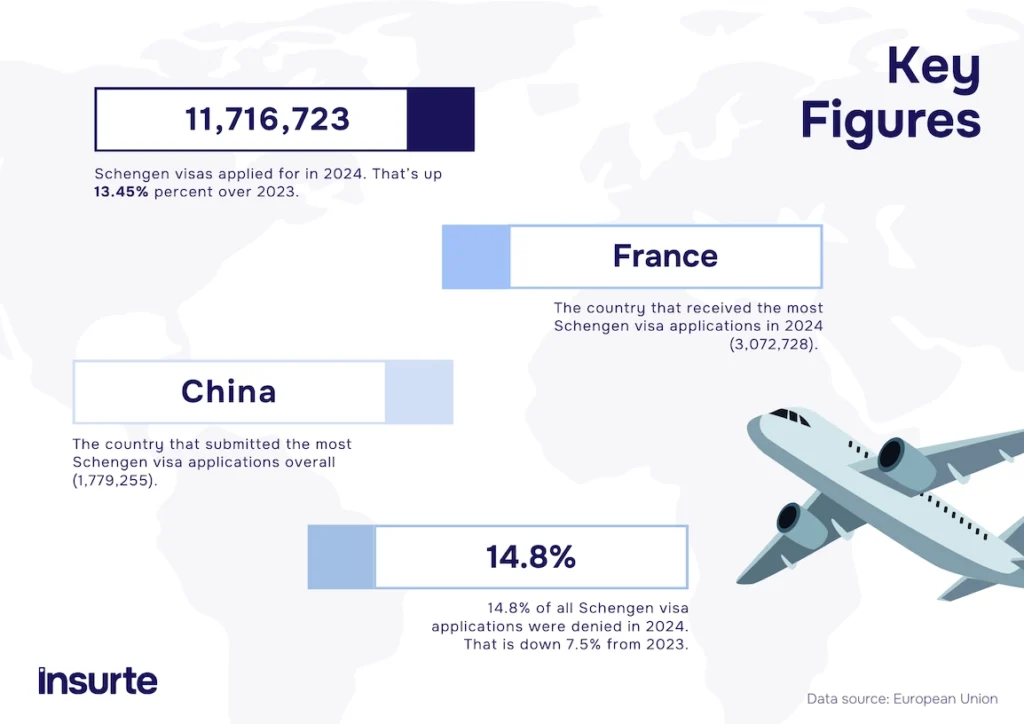
Key details
Growth in volumes
In 2024, 11,716,723 Schengen visa applications were submitted. That is 13.45% more than were submitted in 2023. Schengen travel is continuing to grow, overall.
The Schengen area comprises 29 European countries, including popular countries like France, Germany, and Spain. While there is significant growth overall in applications, some countries saw greater growth than others.
France is the #1 destination
France sees more Schengen visa applications than any other country in the zone. This was proven true again in 2024.
France received 3,072,728 applications, which is over a quarter of all the Schengen applications received (for 29 countries).
China submits the most applications
Out of all of the countries in the world, the most Schengen visa applications came from China in 2024.
Chinese residents were responsible for 15.1% of all Schengen visa applications submitted.
Schengen visa rejection rates decrease
In 2024, 14.8% of all Schengen visas were denied. This is down 7.5% from 2023.
Still, rejection rates are significantly higher than they were pre-pandemic.
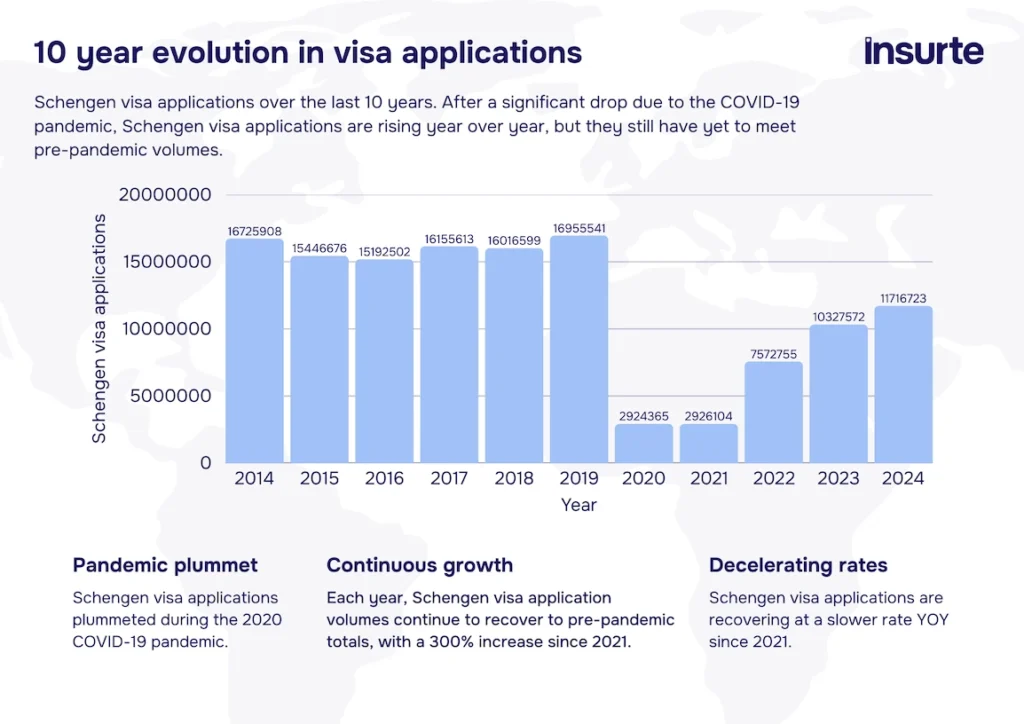
Schengen visa volumes: A 10-year evolution
The COVID-19 Pandemic threw a wrench in rising application numbers.
2019 saw a banner year in application volumes, but that dropped significantly in 2020.
Since 2022, Schengen visa application volumes have continued to recover, but still haven't met their pre-pandemic numbers. On top of that, growth rates seem to be decelerating.
When it comes to specific countries, some saw strong growth rates this past year, while others saw a decline.
Countries with growing Schengen visa application volumes
Most countries are seeing growth in volumes, especially since the pandemic, but Norway, Iceland, Malta, Sweden, and Austria have seen a significant rebound since 2021.
Norway, specifically, is up 1416% in volumes.

Two countries have seen a downturn in Schengen visa applications since 2021: Estonia and the Czech Republic. That said, the Czech Republic is now seeing a more positive upward trend after an initial decline.
Estonia continues to see volatility year over year, with applications dropping another 8.08% from 2023.
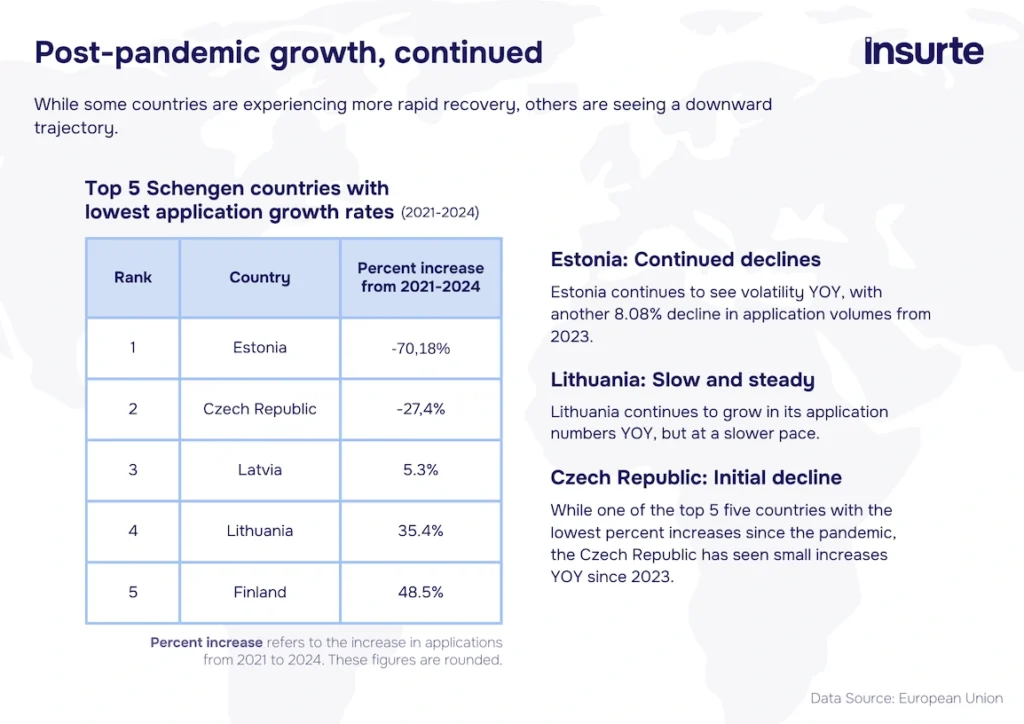
Latvia, Lithuania, and Finland are all seeing growth, but slower growth when compared to other Schengen countries.
Still, with both the more rapidly recovering countries and those that seem to be stalling, the overall trend is up.
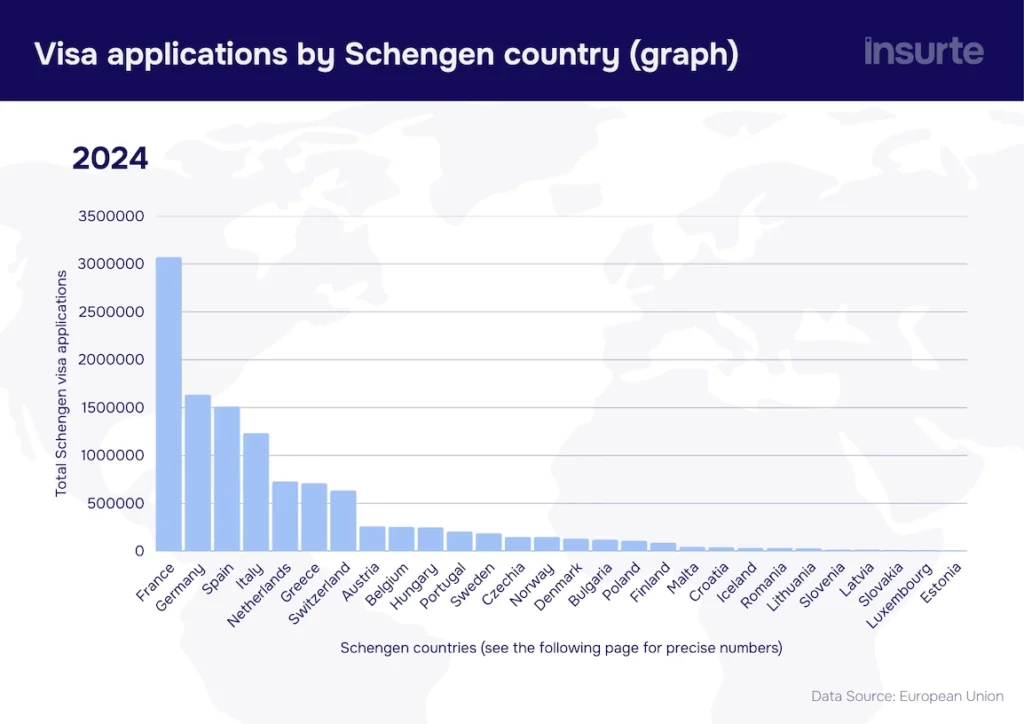
Visa applications by Schengen country
As noted above, France received the most Schengen visa applications out of all Schengen countries in 2024.
The top 10 Schengen countries that received the most Schengen visa applications were:
- France
- Spain
- Germany
- Italy
- Netherlands
- Greece
- Switzerland
- Austria
- Belgium
- Hungary
- Portugal
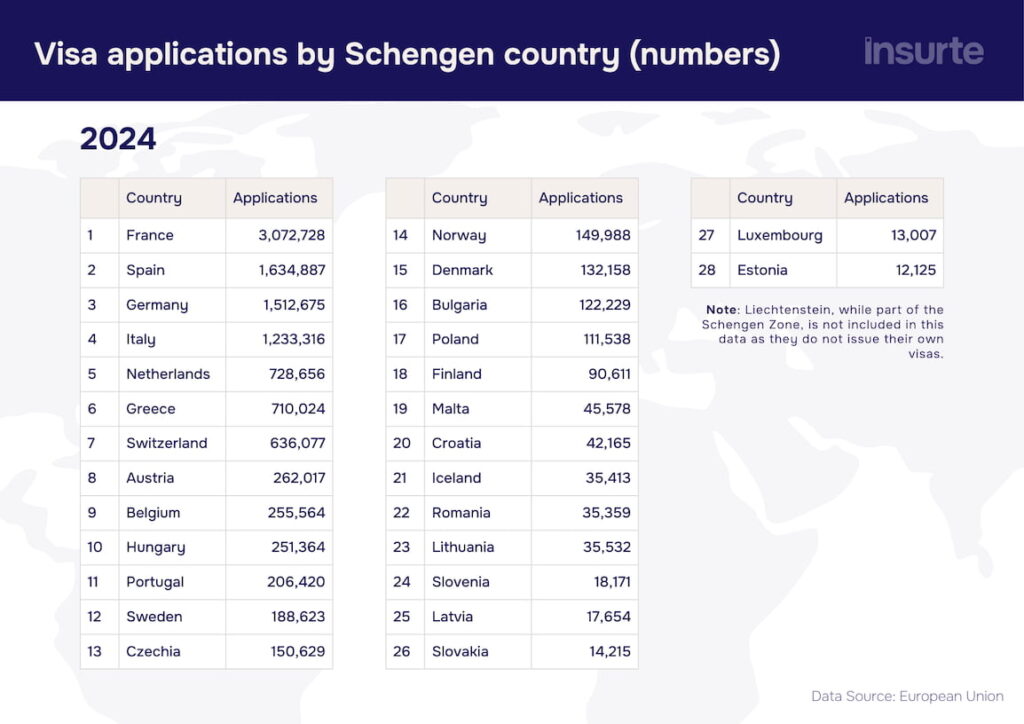
Four countries received over 1M applications
France, Spain, Germany, and Italy received over 1 million applications each. These four countries alone received nearly 70% of all Schengen visa applications submitted globally.
Estonia received the fewest applications
Out of the more than 11 million Schengen visa applications submitted, only 12,125 of them were for Estonia.
Countries that received the fewest Schengen visa applications
- Estonia
- Luxembourg
- Slovakia
- Latvia
- Slovenia
- Lithuania
- Romania
- Iceland
- Croatia
- Malta
Now, just because some of these countries received the fewest number of applications, it doesn't mean their Schengen visa application volumes are growing or declining.
For example, Iceland has low volumes when compared to many Schengen countries, but it's seeing the most exponential growth in applications out of all 29 members.
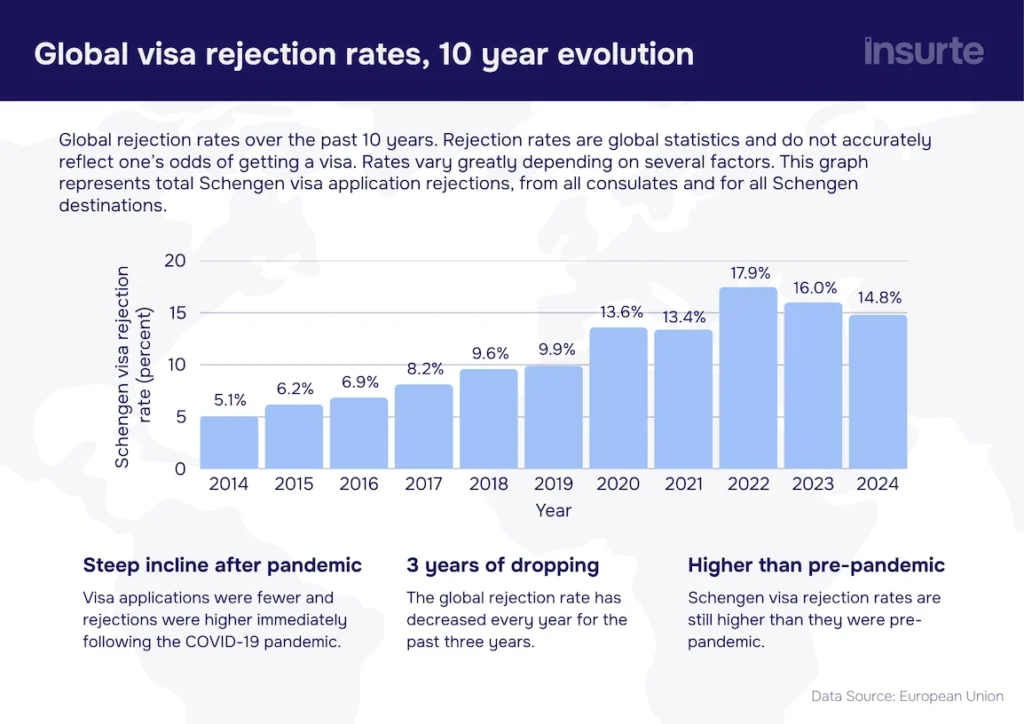
Global rejection rates: A 10-year evolution
Global rejection rates don't accurately reflect one's odds of getting a Schengen visa. Whether or not a visa is approved or denied depends on a myriad of factors.
The chart above and the numbers in this report represent total Schengen visa application rejections from all consulates for all Schengen destinations.
Rejection rates are higher than 10 years ago
Visa rejection rates were gradually increasing until the pandemic, when they rapidly escalated.
2022 had the highest rejection rates in the past 10 years. 17.9% of all Schengen visa applications, globally, were denied.
However, since 2022, rates have dropped every year. That said, they are still higher than they were pre-pandemic.
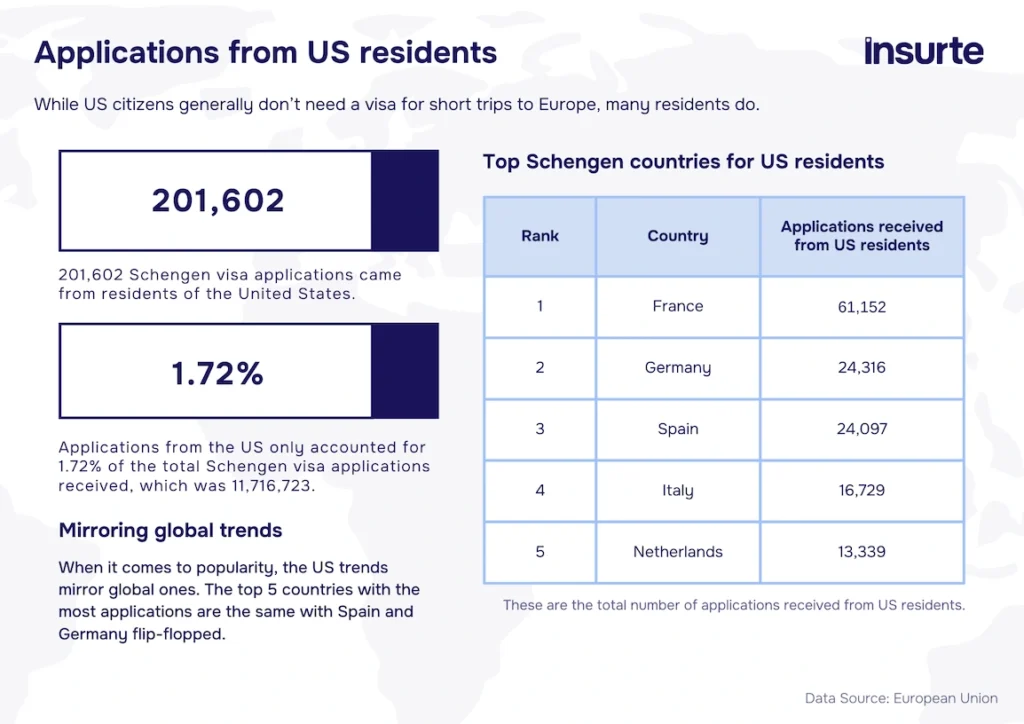
Applications from US residents
US citizens generally don't need a visa to visit the Schengen zone, but many US residents do, as visa requirements don't depend on your residency; they depend on your nationality (among other things).
201,602 Schengen visa applications were submitted by US residents, which only makes up 1.72% of all Schengen visa applications received globally.
The top destinations for US residents mirrored global favorites, with France coming in at number one. Instead of Spain in second, US residents opted for Germany.
Get more data points about Schengen visa applications received from US residents by accessing the entire report.

Applications from UK residents
Britons are in a similar position as US Americans. While citizens of the United Kingdom don't need a visa for short trips to the Schengen area, many UK residents do.
UK residents submitted over twice as many Schengen visa applications as US residents did: 470,569. This accounted for 4.01% of all Schengen visa applications submitted globally.